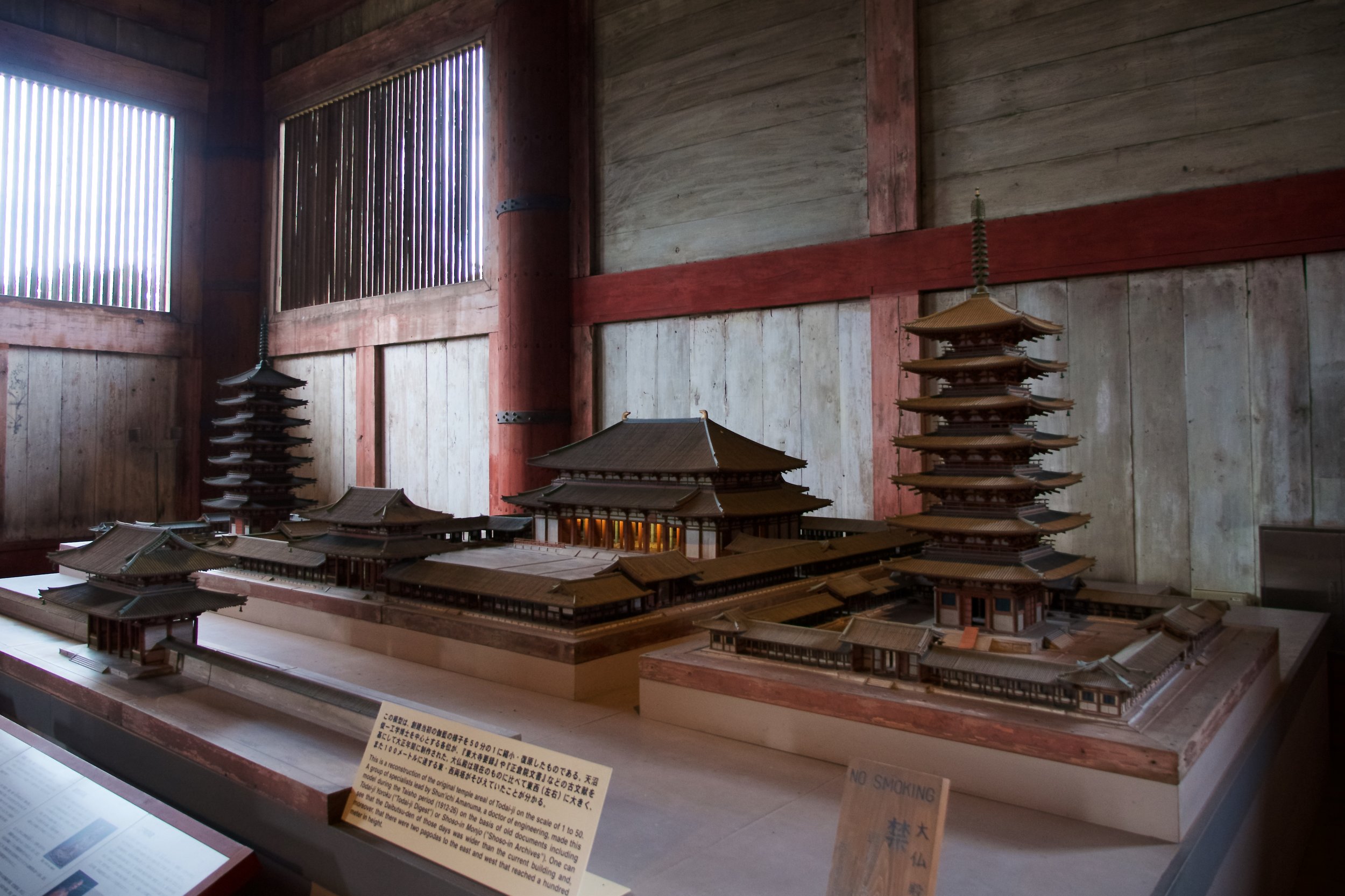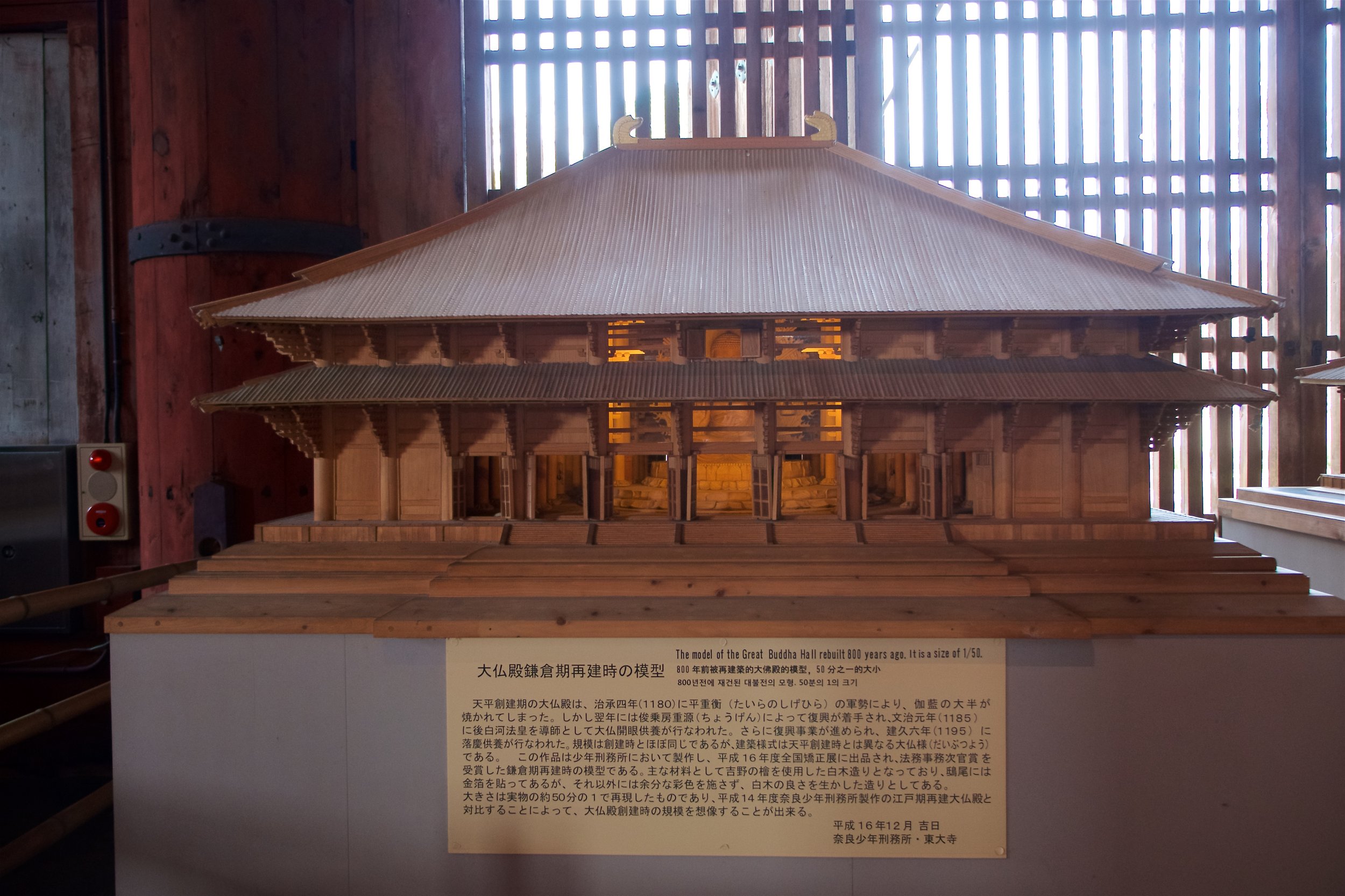Kyoto and Nara, Monday 31-Oct
Having been to the current capital (Tokyo) and the former capital (Kyoto), it was time to visit an even earlier capital of Japan (most of the 8th century, known as the Nara period) and frolic with the deer. Well, we didn't actually frolic.
As has become our daily routine, we started at Kyoto Station. In fact, it was the same train line that we took the previous day to Fushimi Inari, but instead of taking the local train for two stops, we took the rapid (express) train for about 45 minutes. We knew to arrive early and were first in our particular line. While waiting, we saw a freight train go through, which had some standard shipping containers but also had smaller ones. It would have made sense if two containers were the same as a standard one (they were close), but they were a bit shorter, too.
Nara is known for its deer, and they run with the branding. Utility covers, signs, cartoons, basketball team (the Bambitious Nara; Bambi, get it?) are all associated with deer. With all of the hype, we wondered if we would see many, or any.
Nara
We considered taking a bus over to our first destination, Todaiji Temple but decided to walk through the city. It was fun watching the people, looking at the stores and the signs, and stretching our legs from the train ride in general. Once we got to Nara Park, we had our first deer sighting. We needn't have worried; soon we were seeing dozens of deer at a time. People were feeding them sika senbei; you can buy a half dozen of them for ¥150, but there were enough people doing so we had fun just watching. There are claims that some of the deer have learned to bow after being fed; that feels like anthropomorphizing to me, although I did see some deer wait at a crosswalk for traffic to die down, then look both ways as it crossed.
People posed with the deer, petted them, and were in awe of them in general. Makes sense, since they're regarded as heavenly animals which protect both Nara and Japan. The deer you see in Nara are relatively small and quite docile, but you do see signs reminding you that they're wild animals, and can still be aggressive at times. Most people were genuinely eager to interact with them, but some weren't. A few times I saw one person posing, urging another to take a photo, only to have the photographer bail because another deer came up from behind; those photographers wanted nothing to do with the deer.
As we continued through Nara Park, we noticed a bunch of tents and food trucks being set up. It was some sort of festival, so we earmarked that as a lunch possibility. Just past there we saw a sign for Todaji Temple, pointing towards an underground walkway. We took that, and after a while emerged again to the sidewalk, crossed the street, and were nearly there.
Todaiji Temple
This temple is the largest in Nara and has the world's largest bronze Buddha Vairocana, which is the embodiment of the Buddhist concept of emptiness. Housing the statue is what was, until just the past decade, the world's largest wooden building. As if that weren't impressive enough, the former building used to be half again as large before it burned.
It's easy to say things are the largest, so some numbers. The statue is almost 50 feet tall; just the face is over 17 feet. It weights about 500 ton. The building is almost 190 feet long and 160 feet wide.
When you get your first sight of the building, it does look impressive. There's a huge lantern in front which looks tiny in comparison. At the time, a Vietnamese tour was taking a group photo in front; I just went ahead and took the photo anyway. People looked small next to the statue, but they looked minuscule next to the building or even way in front of it.
As you step into the building, you don't see much. Once your eyes start to adjust to the dark, you begin to see the statue (there's a skylight over it which is opened rarely). Flanking it are two smaller (but still huge) golden bodhisattvas. You can walk all around the building, and tucked in a back corner are scale models of the Todaiji complex, as well as former incarnations of the building.
There's also a pillar with a hole cut at the bottom which is the same size as one of the main statue's nostrils. Those who pass through that hole will be blessed with enlightenment in their next life. A school group was there and all the kids were lining up to fit through the hole, adults pulling them. We didn't try, telling ourselves the line was too long.
What was interesting is this temple only wanted you to not use tripods when taking pictures inside the temple. This is counter to many of the temples and shrines we've visited; you can take pictures of the outside, but not of the inside. Some places are more vocal about it than others (one said there are security cameras in use, although I couldn't spot them; another said that cameras would be inspected on the way out and seized if there were photos of the inside, but I wasn't checked). I do want to respect the desire to not have photographs diminish the importance of the site, which is why at many temples I just describe what we saw rather than showing pictures.
Looking at the map, all of the things we wanted to do were on the eastern part of Nara Park, while the food trucks were on the western side. We decided to do one more temple which wasn't too far away since it seemed like it wouldn't take that much time.
Nigatsu-do
We felt pretty lucky that Todaiji Temple was flat since we had been doing a lot of stairs for the past few days. Nigatsu-do brought the stairs back. It's built into the side of a hill, and as such, offers a commanding view of the temples in Nara Park, as well as Nara itself. We spent a few minutes admiring the sight, then started back down another set of stairs, this one covered. As we neared the bottom, we heard one woman say that they had gotten to 20 steps, but would stop counting. We looked at each other, thinking of all the steps we took at Fushimi Inari to get to the top of the hill.
Time to find lunch. Actually, it was time to try to remember where the food trucks were. We tried to mostly undo our path towards Todaiji, going past long lines for the museum (the sign said a 30-minute wait to get in, but it looked a lot longer than that). We finally caught sight of the tents and made a beeline.
Lunch
We started looking at the food trucks, realizing that all the ones we were going by were some sort of ethnic (non-Japanese) food. While it would have been interesting to try a Japanese interpretation of Mexican or Italian (we've walked past several Italian restaurants), we kept on looking. When we saw one selling onigiri and chirashi, we went for that. The chirashi was in a round balsa box with a lid, which made for a really nice presentation. We ate only one of the rice balls, saving one for later.
A woman approached us while we were eating asking if we would fill out a survey. It asked questions about how we found out about the festival, how we liked different aspects of it, etc. Pretty easy, pretty quick.
Kasuga-taisha
It was back to the eastern part of Nara Park after lunch. This time we walked through the Kasugayama primeval forest towards Kasuga-taisha. We noticed that there were sections of trees which were fenced off, and it was readily apparent that those trees still had all their leaves at deer height and lower. Some of the trees not in the fences had mesh around the trunk, presumably to protect them, too.
We reached Kasuga-taisha, which is known for its thousands of stone lanterns. They get lit twice a year, during the festivals of Setsubun Mantoro in February and Obon Mantoro in August. When you first walk up you see them lining the pathway. As you get closer, you see them in double rows, then in large grids.
On our walk back to the train station, we walked through the Naramachi District, another shopping street. Several traditional residential buildings and warehouses have been preserved and now make up the shops and cafés that line the streets. The houses served as both retail space and living quarters and were long and narrow to save on taxes, which were assessed on how much of the street the building had access to.
After leaving Naramachi, we walked through another food market, then turned to make a direct line towards the train.
Dinner
It seemed the Nara Station was the start of our train back. When we got in, we saw people turning the seats around. However, unlike the Shinkansen where the whole row of seats rotates, the seat backs are on a hinge and swing to the other side of the seat cushion (the seat backs are double-sided so both can be used as the back).
After arriving in Kyoto Station, we made the familiar trek back to the hostel, hung out for a couple hours, then went to a local place to have okonomiyaki for dinner. It's a Japanese-style pancake, with veggies mixed in. Melody had squid added to hers, while I had their specialty, which was a plain pancake with bacon, yam, green onions, and an egg on top. They were made right in front of us on a teppan grill. When we walked in, he was making an okonomiyaki for another couple who were already seated, which they shared. They later ordered chicken yep-an, which he began cooking as ours were finishing up.
As orders were ready, he would place them on the outer part of the grill, right in front of us. We had little spatulas that we could use to cut pieces of the okonomiyaki and eat on our plates. For the chicken teppan, he arranged and plated everything on a big scoop, then slid everything in front of the other couple.
If you've been to a teppan restaurant in the US, you're familiar with the flashy cutting, flipping, rattling of the salt and pepper shakers, and other moves which make a good show. Our chef was very utilitarian, using an economy of motion. Instead of a big toque and chef's smock, he was wearing an Under Armour t-shirt and backward cap. The restaurant had eight seats, so in theory, that's how many orders he manages as people arrive and leave, rather than everyone being seated at the same time so he can coordinate everything together. It was interesting to see him juggle the orders for the four of us; it would be more interesting with more people.
Being satisfied with our evening meal, we picked up breakfast food from the store and called it a night.































